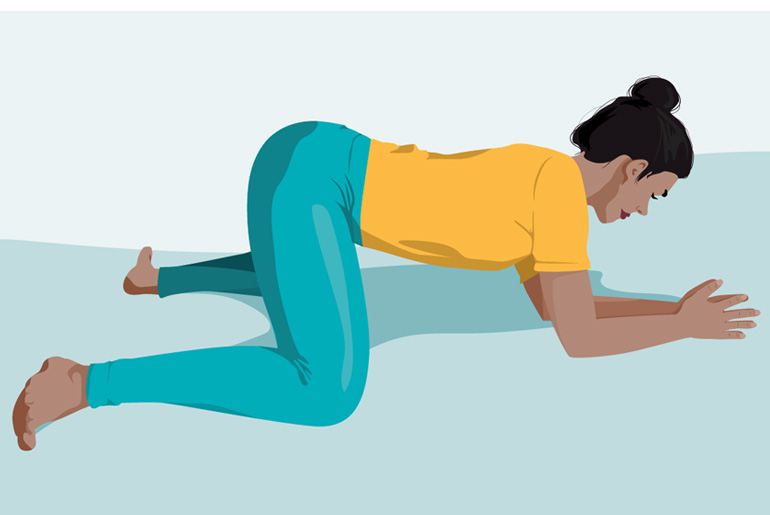Frog Pose:
Frog Pose, or Mandukasana, is a yoga posture that targets the hips, groin, and inner thighs, offering benefits such as increased flexibility and improved range of motion in these areas.
How to perform Frog Pose:
- Begin in a tabletop position on the floor, with your hands directly beneath your shoulders and your knees beneath your hips.
- Shift your weight slightly forward onto your hands as you gradually slide your knees out to the sides, wider than your hips.
- Keep your knees bent at approximately 90-degree angles, and align your ankles with your knees, so your shins are perpendicular to the floor.
- Rotate your feet outward slightly, so the inner edges of your feet are resting on the mat.
- Lower your forearms to the floor, or if possible, come down onto your elbows for support.
- Allow your hips to sink back towards your heels, feeling a deep stretch through the inner thighs and groin area.
- Keep your spine long and your chest open as you hold the pose, breathing deeply and maintaining steady awareness of your body.
- Hold Frog Pose for several breaths, gradually working up to longer durations as your flexibility improves.
- To release the pose, gently press into your hands, lift your hips, and slide your knees back together to return to the starting tabletop position.
Frog Pose is a powerful hip opener that can help improve flexibility and mobility in the hips and groin area. It’s important to practice this pose mindfully, respecting your body’s limits and avoiding any discomfort or strain. If you have any hip or knee injuries, or if you’re pregnant, it’s advisable to consult with a qualified yoga instructor before attempting Frog Pose.
Frog pose offers a range of benefits:
- Easing Pain: Frog pose stretches and strengthens various muscles, including the inner thighs, groin, hips, and lower back. It can help alleviate discomfort or pain in these areas by improving flexibility and releasing tension.
- Improving Circulation: The deep hip opening in frog pose can enhance blood flow to the pelvic region and lower body. Improved circulation supports overall cardiovascular health and can also aid in better nutrient and oxygen delivery to tissues and organs.
- Enhancing Digestion: Frog pose engages the abdominal muscles and stimulates the digestive organs, such as the stomach and intestines. This gentle compression and massage of the digestive system can help improve digestion, relieve bloating, and alleviate constipation.
- Stress Relief: Practicing frog pose involves mindful breathing and focused awareness on the body. This meditative aspect of the pose can promote relaxation, reduce stress, and calm the mind. Deep breathing during frog pose can also activate the parasympathetic nervous system, inducing a state of relaxation and tranquility.]
- Hip Flexibility: Frog pose is particularly effective in stretching and opening the hip flexors, groin, and inner thighs. Regular practice can increase hip flexibility, which is beneficial for activities that require a wide range of motion, such as walking, running, or dancing.
- Preventing Injury: By improving flexibility and range of motion in the hips and lower body, frog pose can help prevent injuries, especially in activities that involve repetitive movements or sudden changes in direction.
- Stimulating Energy Flow: Frog pose is believed to activate the Svadhisthana (sacral) chakra, which is associated with creativity, passion, and emotional balance in yoga philosophy. By opening and energizing the pelvic region, frog pose may enhance the flow of prana (life force energy) throughout the body, promoting vitality and well-being.
- Improving Posture: Strengthening and stabilizing the muscles around the pelvis and lower back in frog pose can contribute to better posture alignment. This can alleviate strain on the spine and promote a more upright and balanced posture in daily activities.
Overall, incorporating frog pose into your regular yoga practice can offer a multitude of benefits for both the body and mind, promoting holistic well-being and vitality. As with any yoga posture, it’s essential to listen to your body, practice mindfully, and seek guidance from a qualified instructor if you’re new to the pose or have any underlying health concerns.
Who Should Try It and Who Should Avoid It:
Frog pose can offer various benefits for flexibility, circulation, digestion, and stress relief. However, like any yoga pose, it may not be suitable for everyone. Here’s a guide on who should try frog pose and who should approach it with caution or avoid it altogether:
Who Should Try Frog Pose:
- Yoga Practitioners: Individuals who have experience with yoga and are looking to deepen their practice by exploring hip-opening poses can benefit from trying frog pose.
- Athletes: People involved in sports or activities that require hip flexibility and strength, such as dancers, runners, or martial artists, may find frog pose helpful in improving performance and preventing injuries.
- Individuals with Tight Hips: Those who experience tightness or stiffness in the hips, groin, or inner thighs can benefit from the gentle stretching and opening provided by frog pose.
- People with Digestive Issues: Frog pose may help individuals experiencing digestive discomfort, bloating, or constipation by stimulating the digestive organs and promoting better digestion.
- Individuals Seeking Stress Relief: The meditative aspect of frog pose, combined with deep breathing and focused awareness, can be beneficial for reducing stress, calming the mind, and promoting relaxation.
Who Should Approach Frog Pose with Caution:
- Pregnant Individuals: Pregnant women should approach frog pose with caution, especially during the later stages of pregnancy. It’s essential to consult with a healthcare provider and a qualified yoga instructor before attempting this pose to ensure it’s safe for both the individual and the baby.
- Individuals with Knee or Hip Injuries: People with knee or hip injuries, particularly those affecting the inner thigh or groin area, should approach frog pose with caution or avoid it altogether. Modifications or props may be necessary to prevent further strain or discomfort.
- Individuals with Lower Back Issues: Those with lower back pain or spinal conditions should practice frog pose mindfully and avoid deepening the stretch if it exacerbates their symptoms. Engaging the core muscles and maintaining proper alignment can help protect the lower back during this pose.
- Beginners: Beginners to yoga or individuals with limited flexibility may find frog pose challenging initially. It’s essential to approach the pose gradually, listen to your body, and not push beyond your limits to avoid strain or injury.
Who Should Avoid Frog Pose:
- Recent Hip Surgery: Individuals who have undergone recent hip surgery or have hip implants should avoid frog pose unless specifically cleared by their healthcare provider. It’s crucial to follow medical advice and refrain from activities that could compromise healing or stability.
- Severe Knee Issues: People with severe knee issues, such as acute injuries or chronic conditions like osteoarthritis, should avoid frog pose as it can place excessive strain on the knees. Alternative hip-opening poses with less knee flexion may be more suitable.
- High Blood Pressure: Individuals with uncontrolled high blood pressure should avoid practicing frog pose, as the inversion and deep breathing may temporarily increase blood pressure levels. It’s essential to prioritize poses that promote relaxation and stability for those with hypertension.
- Recent Abdominal Surgery: Individuals recovering from recent abdominal surgery, such as hernia repair or abdominal organ procedures, should avoid frog pose to prevent strain on the surgical site and promote proper healing. It’s advisable to consult with a healthcare provider before resuming yoga practice.
Overall, while frog pose can offer numerous benefits for many individuals, it’s essential to practice mindfully, respect your body’s limitations, and seek guidance from a qualified yoga instructor or healthcare provider, especially if you have any underlying health concerns or medical conditions. Listening to your body and honoring its needs is key to a safe and enjoyable yoga practice.
Frog Pose, also known as Mandukasana, can indeed provide numerous health benefits, including improved flexibility and range of motion in the hips and joints. However, it’s crucial to approach this pose with caution, especially if you’re a beginner, as it can be quite intense. It’s recommended to ease into the pose slowly and gently, listening to your body and avoiding overexertion. Individuals with lower body or lower back injuries, or those who are pregnant, should either avoid Frog Pose altogether or consult with a healthcare professional before attempting it.
While anecdotal evidence and personal experiences may suggest various benefits of Frog Pose, scientific research on individual yoga poses is limited, making it challenging to determine their universal effects. Therefore, it’s essential to approach Frog Pose mindfully and recognize that its benefits may vary from person to person.
Disclaimer:
The information contained in this article is for educational and informational purposes only and is not intended as a health advice. We would ask you to consult a qualified professional or medical expert to gain additional knowledge before you choose to consume any product or perform any exercise.








